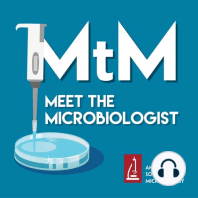24 min listen

086: Toxoplasma gondii and neuro-invasive disease with Anita Koshy
086: Toxoplasma gondii and neuro-invasive disease with Anita Koshy
ratings:
Length:
36 minutes
Released:
Jul 12, 2018
Format:
Podcast episode
Description
How is Toxoplasma gondii, a protozoan that causes neuro-invasive disease, transmitted as a foodborne pathogen? Why are cats important in transmitting Toxoplasma infection? Anita Koshy answer these questions and talks about her research on the latest Meet the Microbiologist. Julie’s Biggest Takeaways: The primary host for T. gondii is cats, in which the protozoan can undergo sexual reproduction. Why cats? No one knows, in part because there isn’t a good in vitro system to study cat epithelial cell interactions with T. gondii. Most warm-blooded animals, including birds, can be infected with Toxoplasma. Intermediate hosts can pass Toxoplasma from one to another if one eat these tissue cysts, explaining why Toxoplasma can be a foodborne pathogen. In healthy individuals, the immune response clears most fast-growing cells (tachyzoites) but some protozoans convert to a slow-growing cell form (bradyzoites). In people, these bradyzoites form cysts predominantly in the brain, the heart and the skeletal muscle. Some serological studies suggest a tie between Toxoplasma infection and brain disorders, but these are less definitive than causative studies in mice. Populations with high Toxoplasma or low Toxoplasma prevalence don’t see a correlative incidence of disorders such as schizophrenia or Alzheimer’s disease. Featured Quotes: “When we talk about neuroinfectious diseases, we’re talking about the diseases that cause symptoms. Those that can get into the central nervous system and those that cause symptomatic disease are the same.” “A parasite is sitting there dormant or maybe reactivating every so often and the immune system comes in and deals with that reactivation. But when you lack an immune system, all of a sudden when that parasite reactivates, there is no longer this immune system that will come in and clear it out.” “What we don’t know is whether reactivation occurs preferentially in the brain. There is evidence from HIV patients of inflammation of the heart or inflammation of the skeletal tissue - but those weren’t the symptoms that presented, which were of the brain. Did reactivation happen in the brain, or did it occur elsewhere and the parasite was able to travel to the brain and there’s no longer an immune system to clear it out?” Links for this Episode: Koshy Lab Site Sea Otter Infection with Toxoplasma Rats Infected with T. gondii Lose Their Aversion to Cat Urine HOM Tidbit: The History of Toxoplasma gondii Bill Hutchinson obituary
Released:
Jul 12, 2018
Format:
Podcast episode
Titles in the series (100)
MTS6 Bruce Rittmann - Microbes, Waste and Renewable Energy by Meet the Microbiologist